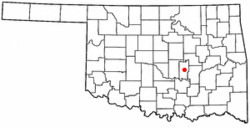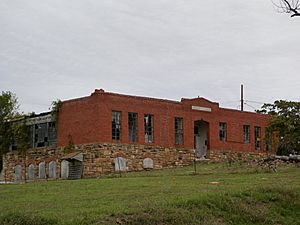Lima, Oklahoma facts for kids
Quick facts for kids
Lima, Oklahoma
|
|
|---|---|

Location of Lima, Oklahoma
|
|
| Country | United States |
| State | Oklahoma |
| County | Seminole |
| Area | |
| • Total | 0.47 sq mi (1.22 km2) |
| • Land | 0.47 sq mi (1.22 km2) |
| • Water | 0.00 sq mi (0.00 km2) |
| Elevation | 889 ft (271 m) |
| Population
(2020)
|
|
| • Total | 68 |
| • Density | 144.07/sq mi (55.57/km2) |
| Time zone | UTC-6 (Central (CST)) |
| • Summer (DST) | UTC-5 (CDT) |
| FIPS code | 40-43000 |
| GNIS feature ID | 2412895 |
Lima is a small town in Seminole County, Oklahoma, United States. It is special because it is one of the few remaining "All-Black towns" in Oklahoma. These towns were created by African Americans, often after the American Civil War, to build their own communities.
In 2020, the town had a population of 68 people. This was a small increase from 53 people in 2010.
Contents
The History of Lima
The community of Lima was named after the local limestone quarries. These quarries were places where limestone rock was dug out of the ground. They existed in the area by 1904.
Early Days and Growth
Lima had its own post office from 1907 until 1957. The very first postmaster was named Grudge V. Gross. In 1913, Lima officially became an incorporated town. This meant it had its own local government. The town was built along a railroad line, which was important for travel and trade. A local newspaper, the Lima Observer, started in 1914.
Education and New Neighbors
In 1921, a special school called Rosenwald Hall was built in Lima. This school was helped by the Rosenwald Fund, which supported education for African American children in the South. The school served the community until it closed in 1966.
In 1926, a large oil field called the Greater Seminole Oil Field was discovered nearby. This brought many new people to the area. Some White residents moved to Lima and created a separate village to the east, which they called "New Lima".
Where is Lima Located?
Lima is located in Seminole County, Oklahoma. According to the United States Census Bureau, the town covers an area of about 0.5 square miles (1.22 square kilometers). All of this area is land, with no water.
Population Changes Over Time
| Historical population | |||
|---|---|---|---|
| Census | Pop. | %± | |
| 1920 | 146 | — | |
| 1930 | 239 | 63.7% | |
| 1970 | 238 | — | |
| 1980 | 256 | 7.6% | |
| 1990 | 133 | −48.0% | |
| 2000 | 74 | −44.4% | |
| 2010 | 53 | −28.4% | |
| 2020 | 68 | 28.3% | |
| U.S. Decennial Census | |||
The population of Lima has changed a lot over the years. In 1930, it had its highest population with 239 people. By 2010, the population had dropped to 53 people. However, it saw a small increase to 68 people by 2020.
Education in Lima
Students in Lima attend schools within the New Lima Public Schools district.
See also
 In Spanish: Lima (Oklahoma) para niños
In Spanish: Lima (Oklahoma) para niños


